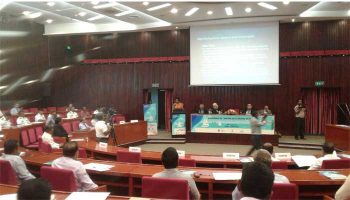Shocking truths about shock treatment

 By Dr. Marcel de Roos (Psychologist PhD, the Netherlands)
By Dr. Marcel de Roos (Psychologist PhD, the Netherlands)
Electroconvulsive treatment (ECT) or electroshock as it used to be named remains a very controversial topic. In Sri Lanka it is not openly discussed and the official line is that it’s a safe and effective treatment. Internationally speaking, the debate over ECT rages for decades and is often emotional and murky.
Much information and research about ECT is done or funded by stakeholders. A striking example of this is Professor Edward Shorter. He speaks at psychiatrist’s conferences and in 2012 he wrote a book (with David Healy) called “Shock therapy: a history of electroconvulsive treatment in mental illness”. As with any scientific book or article, and especially with such a controversial topic like ECT, it’s important to be critical.
Edward Shorter is not a psychiatrist but an historian who writes about psychiatry. The above mentioned book is biased, if only because the authors combine both historical analysis and advocacy. They give a very one sided account of the existing ECT-literature, they leave out important studies, they totally disregard important issues (like the rapid relapse of most patients after shock and high percentages of permanent memory loss and loss of concentration), there is no mentioning of the reluctance in the psychiatric world to set up proper studies about the effects of ECT, there is no evidence of a long-term protective effect against suicide, the experiences of patients are mostly dismissed, etc., etc.
Even worse, on the first page of the Acknowledgments section of the book it becomes clear that an important part of the funding for the writing of the book (according to public records $ 34,000) came from a foundation of Max Fink (often called “the grandfather of shock”). He has been promoting ECT for decades, has interests in a shock machine manufacturing company, publishes books and articles denying any adverse effects of ECT, and in effect co-wrote Shorter’s book. For a historian, Edward Shorter hasn’t done a good job and he pays lip service to the ECT industry and its advocates.
Marcia Angell, for some twenty years an editor of The New England Journal of Medicine, wrote about her disappointment that in particular psychiatry has allowed itself to be thoroughly corrupted by its extensive ties to the pharmaceutical industry. In a similar way, the National Institute of Mental Health in the USA, which is the prime source of funds for ECT research, has been controlled for decades by a small group of psychiatrists of which many with strong financial ties to shock machine manufacturers. Therefore, as researcher it’s very difficult to get funding for a study about for example the side effects of ECT. It’s much easier to write about shock industry approved topics.
ECT is the most lucrative psychiatric procedure and the majority of the insurance companies will pay for it. The rate of imbursement by insurance is higher than anything else a psychiatrist can do in 30 minutes. Given these financial rewards, it’s clear that the stakes are high. Psychiatrists rely on literature, conferences and workshops that in most cases are influenced by ECT-friendly stakeholders. As a psychiatrist one should be aware of all this and be critical.
Besides the likes of Shorter there are other authors, such as Professor Linda Andre and psychiatrist Dr Peter Breggin, who in their books and articles DO write about the above mentioned shortcomings in the ECT-literature. Linda Andre (who received ECT herself) wrote in 2009 “Doctors of deception: what they don’t want you to know about shock treatment”. Like Shorter, her book is also about the history of shock treatment since its appearance in 1938, but written from a totally different angle. She meticulously investigated court records, medical research, Federal Drug Administration (FDA) archives and other primary sources. Her book challenges claims of safety and efficacy made by the medical establishment (which promotes and profits from ECT) and explains that those claims are not validated by scientific evidence. She asserts that a huge amount of the positive accounts and information regarding ECT is fraudulent and given by clinicians and or manufacturers with vested interests. Andre presents a large volume of documented evidence to prove this. She reveals how by an aggressive PR approach ECT- stakeholders for decades have manipulated government-funded research, the FDA, professional medical journals and the media.
The American psychiatrist Dr Peter Breggin is a critic of biological psychiatry and psychiatric medication. On his website www.breggin.com there is an ECT Resources Center with more than 125 scientific annotated articles, a glossary of searchable terms and a brochure for patients and families. He wrote many scientific articles and more than twenty books about psychiatry. In his 2008 book “Brain-disabling treatments in psychiatry: drugs, electroshock and the psycho-pharmaceutical complex” and in his articles about ECT he describes it as follows: “ECT involves the application of two electrodes to the head to pass electricity through the brain with the goal of causing an intense seizure or convulsion. The process always damages the brain, resulting each time in a temporary coma and often flat lining of the brain waves, which is a sign of impending brain death. After one, two or three ECT’s, the trauma causes typical symptoms of severe head trauma or injury including headache, nausea, memory loss, disorientation, confusion, impaired judgment, loss of personality, and emotional instability. These harmful effects worsen and some become permanent as routine treatment progresses”.
One of the most vocal critics of ECT is Professor Dr. John Read from the University of Liverpool. In 2010, John Read and Richard Bentall co-authored a comprehensive literature review on “The effectiveness of electroconvulsive therapy”. It examined placebo-controlled studies and concluded that ECT had minimal benefits for people with depression and schizophrenia. The authors said “given the strong evidence of persistent and, for some, permanent brain dysfunction, primarily evidenced in the form of retrograde and anterograde amnesia, and the evidence of a slight but significant increased risk of death, the cost-benefit analysis for ECT is so poor that its use cannot be scientifically justified”.
Dr. John Read says that what happens is a little like recharging a car battery. It’s not difficult to get artificial changes in the brain, you could do it with cocaine, but it doesn’t last and three or four weeks later the person is either back at the same level of depression or many studies show worse levels of depression. Opponents say that ECT patients can enter into an addictive cycle of repeated treatment and that any improvement beyond the very short term is likely to be little more than an extreme form of the placebo effect, with patients benefitting psychologically from the extra care and medical attention associated with ECT. It’s not in any way addressing the root-cause of their depression. It’s systematically and gradually wiping out their memory and cognitive function.
Another literature study by Colin A. Ross (in Ethical human psychology and psychiatry, February 2006) comes to a similar conclusion. The author reviewed the placebo-controlled literature on (ECT) for depression. No study demonstrated a significant difference between real and placebo (sham) ECT at 1-month post-treatment. Many studies failed to find a difference between real and sham ECT even during the period of treatment. Claims in textbooks and review articles that ECT is effective are not consistent with the published data.
In December 2016 C.R. Blease stated in the Journal of medical ethics that since there is still no explanation how ECT works, although there are a few cases where ECT seemed to have been beneficial, plus the risks of serious side-effects that ECT may produce, the informed consent must include a comprehensive account of these uncertainties.
In the light of the lack of evidence that ECT works and the compelling risks of serious side-effects one should be very careful with deciding to administer ECT. Dr. John Reed is convinced that in 10 or 15 years we will have put ECT in same rubbish bin of historical treatments as lobotomies and surprise baths that have been discarded over time.
In my psychology practice I hear on regular base stories from Sri Lankans who have received ECT while good alternatives were available. In cases of moderate depression, anxiety, or in one case simply a “stubborn young woman” it was administered in a manner like: “let’s just try this out……” Perhaps in extremely serious cases ECT can be used when there is no alternative. Independent long-term studies (at least 4 weeks after the last treatment) show that the cost-benefit analysis of ECT is very poor. They conclude that the risk of damage caused by it cannot justify its continued use. ECT is NOT as safe and innocent as many proponents say. The side effects are often much more intense, lasting and serious than a simple headache……….






